Freestone Streams
A Freestone streams’ water source is either snow melt or rainfall, relying upon precipitation for their flow volume. Freestones generally have steep gradients characterized by areas of rapid and fast currents. They are usually sited in canyon areas.
Freestone streams volume crests in early summer while its flows diminish in the fall and winter. The stark contrast between late spring time and winter flows can be surprising. A once production summer side-channel may be bone dry in the winter. Spring time flows may be high and muddy yet run low and clear the rest of the season. High flows commonly scour stream channels. Rooted aquatic plants have
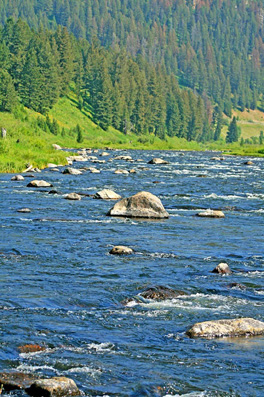
difficulty surviving the seasonal heavy flows. Stream channels can change from one year to the next. Although some scouring may be beneficial by washing away excess silt accumulated in the rocky, gravelly riffled sections. Freestones are distinguished by few rooted aquatic plants and by an abundance of gravel and rocks.
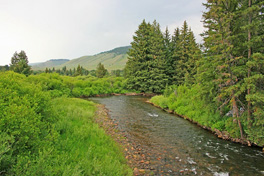
Aquatic insects require plants to exist. Riffles support sheltered areas for limited plant growth. Aquatic insects live and feed in the riffled areas where the enhanced surface areas between the rocks support plant habitat. Hence, the riffles provide the freestone stream with it’s abundance of aquatic insects for the fish to forage.
A freestone streams pH is usually slightly acidic. In times of excess acid plants, insects, and fish may perish. The snow pack at a streams source can accumulate acidic precipitation. This is concentrated into the bottom layer of snow. As this bottom layer melts, the sudden release of acid can be devastating to its downstream environment.
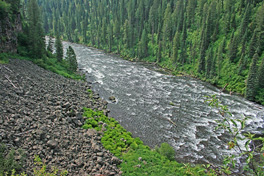
A freestone stream is more readily influenced by the ambient air temperature, resulting in wide fluctuations. Winter cold can run close to freezing while summer heat can exceed 70°F. This wide variation shortens a fishes growing season which occurs when the water temperature is between 55–65°F. The lowered winter and late summer diminished water volume is more easily influenced by ambient temperature changes. Conditions of bottom ice along with an ice lid surface can induce winter kill of both insects and fish. Likewise, summer die-offs occur due to excessively warm waters which forfeits its ability to hold sufficient oxygen.
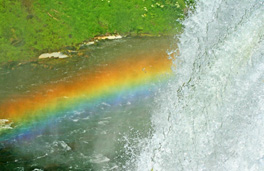
The productive freestone streams are restricted to ideal altitudes and latitudes where seasonal temperatures are favorable for aquatic life.
As a general rule the freestone streams growing season is much shorter than a spring creeks, because freestones are more prone to wide temperature fluctuations.
In summary, freestones are subject to times of plenty and to times of drought. They are not as rich in food resources as spring creeks. Their grace is that freestones are wider, longer and more numerous than spring creeks. Nonetheless freestones are less crowded than spring creeks. Since freestones have fewer fish than a spring creek, an angler must cover more water in search of fish.
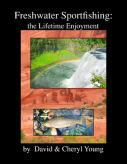
© 2025 The Gale Group, Inc. All rights reserved.
© 2025 Perigee Learning LLC. All rights reserved.
LoveTheOutdoors.com is owned and operated by Advameg, Inc. © 2025 Advameg, Inc.
Camping Adventures • Dutch Oven Cooking • Sports Knots
Fly Tying • Freshwater Fishing • Fly Fishing

